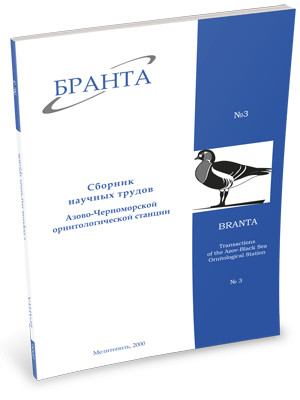
Transactions
of the Azov-Black Sea Ornithological Station



Modern status of Long-legged Buzzard in Ukraine
Grinchenko A.B. , Kinda V.V., Pilyuga V.I., Prokopenko S.P.
Numbers and distribution of Long-legged Buzzard were studied in 1985-2000 in the southern regions of Ukraine, the Crimea and Kiev region. About a hundred records throughout different seasons of the year were analysed. These data are completed by 31 breeding records coming from 25 pairs. Eight more presumed breeding localities were found.
Along with original data, a detailed analysis of published materials referring to the last 150 years was performed. Moreover, some unpublished data were kindly provided by colleagues ornithologists from other parts of the country. According to the published data, an isolated population of Long-legged Buzzard existed in the Forest-Steppe zone of Ukraine, having been restricted primarily to Kirovograd and Cherkasy regions, until the early 80s. From 1912 till 1953 inclusive 6 breeding records were known, of which 2 were actually lacking clear confirmation. In 1980-1982 five breeding records of 3 pairs and a finding of a breeding locality were registered there possible. Since the second part of the 80s and on the species began active expansion resulting in new hot beds of breeding. In 1997 it nests were found in Kiev region, in 1991 - in Nikolaev region, 1994 - in Dnepropetrovsk region, in 1997 - in Crimea, 2000 - in Kharkov region. In the breeding period it was also reported from Odessa, Kherson, Zaporozhye and Donetsk regions. A sharp increase of the population with a clear tendency to further progressing has been especially impressive in the last 3 years (1997-2000) of which the latter seems to be its peak year. A current estimate of the breeding population ranges between 55 and 40 pairs.
Long-legged Buzzards breed exclusively on trees, mainly in the artificial forests, forest belts, rarely in mono-species poplar plantations. Breeding on rocks was recorded twice in the Crimea.
Population increase was followed by expansion of the former breeding range: up to the latitude of Kiev northward, Odessa - in the south-western direction and Kharkov region in the east. Somewhat isolated part of the breeding range is formed in the Crimea, where buzzards breed in the foothills and probably also in the hilly steppes of the Kerch and Tarkhankut peninsulas.
Since 1997 Long-legged Buzzard has been regularly wintering in the Crimean peninsula. Single records also come from the southern districts of the Kherson and Odessa regions. Total wintering population may reach 40-50 birds. Their population status has not been studied yet.
Based on the analysis and comparison of the data concerning state of and trends in the European and Ukrainian populations of the species, the authors tend to conclude that the population increase and breeding range expansion of Long-legged Buzzard come as a result of spreading birds originating from the SE Europe.
Read the paper in a PDF file